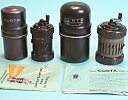The Curtas were marvels of mechanical miniaturization which were introduced by Contina Ltd. in 1948. They were designed by Curt Herzstark while he was a prisoner in a concentration camp. Herzstark worked out the basic design in his head and polished it on paper when he was released in 1945. Herzstack's design was based on the stepped drum mechanism but with a brilliant adaptation that allowed a remarkably simple and compact design.
The small hand held devices could be used to perform the four basic functions and the later manuals included algorithms for cubes and square roots. Besides being much smaller, they were also faster and quieter than their older larger hand driven ancestors. They were far less noisy and only a little slower than the motor driven models. The machines were cylindrical with numbers input on sliding levers around the body. Above each lever was a window that showed the number entered in that position. Below the number levers was a base/grip used to hold the machine and on the top there was a crank called the "operating handle". Also found on the top were two more number registers (the revolution counter and the result dial), decimal markers and a clearing lever.
The operating handle had upper and lower positions with the lower position used for addition/multiplication and the other used for subtraction/division. The handle could only be turned clockwise and a stop gave clear feedback to allow the user to count the number of full turns without watching the revolution counter.
The (silver) revolution counter counted the number of rotations of the operating handle. In an addition, the handle was rotated once for each addition, so the revolution counter counted the number of items added. In the case of multiplication, the revolution counter registered one of the factors. Multiplications were by successive adds, but the user didn't have to turn the crank thousands of times. The crank needed to be turned the number of cranks for each digit in each position.
For example, to multiply by 1024 would require 7 turns - four in the ones position, two in the tens position, and one in the thousands position. The entire wide top section of a curta was the carriage and you can see in the pictures that the carriages had markings on the bottom to indicate the position to which they were set. (See the Large Hand Driven Models section above for more information on multiplying and dividing.) Since the operating handle was easily moved between the add and subtract positions, an error such as turning too many times was easily corrected. Also when multiplying by digits above 5 (for example 8) a clever user could speed things up by making two subtractive turns and then one more additive turn in the next column (because X×8 = X×10 - X×2). This trick would save 5 turns in this case.
The (black) result dial was were answers to most problems appeared. (For subtractive division, the answer was the number of revolutions required to bring the number in the result dial to zero.) The clearing lever had a ring on the end and was concentric with the operating handle. It could be folded close to the body for transport. Swinging it over either dial cleared that dial (there were stops on both sides). Making a complete circle cleared both dials. There was also a reversing lever which reversed the direction of the revolution counter relative to the operating handle. (This made it count subtractions positively for subtractive divisions.)
The Curtas originally came in padded metal cases sealed with gaskets. (Later models came in plastic cases.) The Model I had an 8 column "keyboard" (8 slides), 11 digit results and a 6 digit revolution counter. It was 2.1" in diameter by 3.4" long and weighed 8 oz. The Model II had an 11 column keyboard, 15 digit results and an 8 digit revolution counter. It was 2.6" in diameter by 3.6" long and weighed 12.5 oz. Curtas survived the early electronic desktop calculators due to their portability and lower price, but pocket electronic calculators killed the Curtas in 1972. The samples shown are from the 1950s.

|
Picture of a Curta Model I |

|
Picture of a Curta Model II |

|
Picture of the top of the Model II |

|
Picture of both Curtas and their cases. (With a brochure and instruction manual.) |
![]() Back to early models contents
Back to early models contents
![]() Go on to the Friden SRW
Go on to the Friden SRW
![]() Back to the motor driven models
Back to the motor driven models